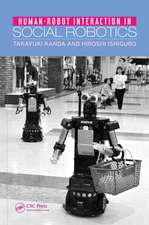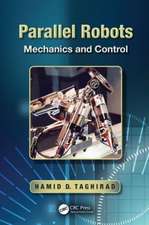Robots, Reasoning, and Reification
Autor James P. Gunderson, Louise F. Gundersonen Limba Engleză Hardback – 26 noi 2008
| Toate formatele și edițiile | Preț | Express |
|---|---|---|
| Paperback (1) | 641.67 lei 6-8 săpt. | |
| Springer Us – 5 noi 2010 | 641.67 lei 6-8 săpt. | |
| Hardback (1) | 646.80 lei 6-8 săpt. | |
| Springer Us – 26 noi 2008 | 646.80 lei 6-8 săpt. |
Preț: 646.80 lei
Preț vechi: 808.50 lei
-20% Nou
Puncte Express: 970
Preț estimativ în valută:
123.78€ • 134.41$ • 103.98£
123.78€ • 134.41$ • 103.98£
Carte tipărită la comandă
Livrare economică 23 aprilie-07 mai
Preluare comenzi: 021 569.72.76
Specificații
ISBN-13: 9780387874876
ISBN-10: 0387874879
Pagini: 201
Ilustrații: XV, 201 p.
Dimensiuni: 155 x 235 x 15 mm
Greutate: 0.45 kg
Ediția:1st Edition.2nd Printing. 2008
Editura: Springer Us
Colecția Springer
Locul publicării:New York, NY, United States
ISBN-10: 0387874879
Pagini: 201
Ilustrații: XV, 201 p.
Dimensiuni: 155 x 235 x 15 mm
Greutate: 0.45 kg
Ediția:1st Edition.2nd Printing. 2008
Editura: Springer Us
Colecția Springer
Locul publicării:New York, NY, United States
Public țintă
ResearchCuprins
Some background material on probability and biology.- Using Cognition and Physiology to Build a Cognitive Model.- Representation.- Perception/Action System.- Design of a Reification Engine.- Bridging the Sensor to Symbol Gap.- Working Memory and the Construction of Personal Experiences.- Semantic Memory and the Personal Rough Ontology.- Deliberative System.- Putting it All Together.- Testing.- Where do we go from here.
Textul de pe ultima copertă
Robots, Reasoning, and Reification focuses on a critical obstacle that is preventing the development of intelligent, autonomous robots:the gap between the ability to reason about the world and the ability to sense the world and translate that sensory data into a symbolic model.
This ability is what enables living systems to look at the world and perceive the things in it. In addition, intelligent living systems can extrapolate from their mental models and predict the effects of their actions in the real world. The authors call this bi-directional mapping of sensor data to symbols and symbolic manipulation onto real world effects reification. After exploring the gulf between bottom-up and top-down approaches to autonomous robotics, the book develops the concepts of reification from biologically based premises, and follows the development into the necessary components and structures that can be used to provide equivalent capabilities for intelligent robots. It continues by demonstrating how the reification engine supports both learning from experience and creating new behaviors and representations of the world.
This ability is what enables living systems to look at the world and perceive the things in it. In addition, intelligent living systems can extrapolate from their mental models and predict the effects of their actions in the real world. The authors call this bi-directional mapping of sensor data to symbols and symbolic manipulation onto real world effects reification. After exploring the gulf between bottom-up and top-down approaches to autonomous robotics, the book develops the concepts of reification from biologically based premises, and follows the development into the necessary components and structures that can be used to provide equivalent capabilities for intelligent robots. It continues by demonstrating how the reification engine supports both learning from experience and creating new behaviors and representations of the world.
Caracteristici
Develops the concepts of reification from biologically based premises Bridges the gap between symbolic AI and reactive robotics The reification engines utilize the concept of a rough ontology for knowledge representation in autonomous embodied systems












